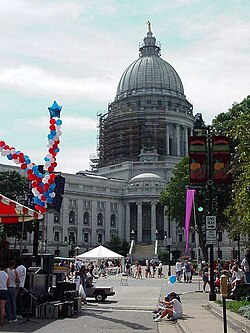Madison is the capital of Wisconsin, a state of the United States of America. As of the 2000 census, it has a population of 208,054. It is the county seat of Dane County. The city completely surrounds the smaller Town of Madison.

The University of Wisconsin's main campus is located in the city. The main downtown thoroughfare is State Street, which links the University campus with the State Capitol square, and is lined with restaurants and shops. Only pedestrians, buses, police and bikes are allowed on State Street. The Capitol Square is situated on the isthmus between lakes Mendota and Monona.
Madison is considered the healthiest city in America by Mens Health magazine.
Notable buildings include the Wisconsin State Capitol, and the Monona Terrace meeting and convention center, based on a design by Frank Lloyd Wright. Wright, who spent a brief time as a student at the University, also designed other buildings in Madison, such as the Unitarian meeting house. In the summer time, on Saturday mornings, the Dane County Farmers' Market is on the Capitol Square.
Madison has three identities—state capital, college town, and working-class city—which blend and synergize. Madison will always be associated with the name of "Fighting Bob" LaFollette and the Progressive movement. La Follette's magazine, The Progressive, founded in 1909, is still published in Madison today.
Two daily newspapers, the Wisconsin State Journal and the Capital Times, are published in the city, which is also the home of a free weekly alternative newspaper, Isthmus. The Onion satirical weekly was also founded in Madison.
In Madison during the sixties, thousands of students and other citizens took part in antiwar marches and demonstrations. These protests were the subject of the documentary The War at Home. The counterculture was centered in the neighborhood of Mifflin and Bassett streets, referred to as Mifflin-Bassett or Miffland. The area contained many three-story apartments where students and counterculture youth lived, painted murals, opened vegetarian restaurants and co-operative grocery stores, and used illegal substances. The neighborhood often came into conflict with authorities, particularly then-Mayor Bill Dyke (who was later to run for vice-president with segregationist Lester Maddox). Tom Bates writes in Rads that Dyke's attempt to suppress the annual Mifflin Street block party "would take three days, require hundreds of officers on overtime pay, and engulf the student community from the Southeast Dorms to fraternity row. Tear gas hung like heavy fog across the isthmus." In the fracas, student activist Paul Soglin, then an alderman, was arrested and taken to jail. Later, Soglin was to become mayor of Madison, serving from 1973 to 1979 and from 1989 to 1997.
In 1996 Money magazine identified Madison as the best place to live in the United States. It has consistently ranked near the top of the best-places list in subsequent years (the list is published annually by the magazine), with the city's consistently low unemployment rate being a major factor in its ranking.
Notable people associated with Madison include Thornton Wilder, Eric Heiden, Tyne Daly and Chris Farley all born in Madison; Charles A. Lindbergh, who entered a mechanical engineering program at the University of Wisconsin in 1920, did poorly, and dropped out to become a barnstormer; and musicians Steve Miller (who attended the University of Wisconsin-Madison) and Otis Redding (who died in a 1967 plane crash in Madison).
Geography
According to the United States Census Bureau, the city has a total area of 219.3 km² (84.7 mi²). 177.9 km² (68.7 mi²) of it is land and 41.5 km² (16.0 mi²) of it is water. The total area is 18.91% water.
Demographics
As of the census of 2000, there are 208,054 people, 89,019 households, and 42,462 families residing in the city. The population density is 1,169.8/km² (3,029.7/mi²). There are 92,394 housing units at an average density of 519.5 persons/km² (1,345.4 persons/mi²). The racial makeup of the city is 83.96% White, 5.84% African American (most of whom reside in such neighborhoods as Allied Drive, Broadway-Lake Point, and Worthington Park), 0.36% Native American, 5.80% Asian, 0.04% Pacific Islander, 1.67% from other races, and 2.32% from two or more races. 4.09% of the population are Hispanic or Latino of any race.
There are 89,019 households out of which 22.1% have children under the age of 18 living with them, 37.0% are married couples living together, 7.8% have a woman whose husband does not live with her, and 52.3% are non-families. 35.3% of all households are made up of individuals and 7.1% have someone living alone who is 65 years of age or older. The average household size is 2.19 and the average family size is 2.87.
In the city the population is spread out with 17.9% under the age of 18, 21.4% from 18 to 24, 32.2% from 25 to 44, 19.3% from 45 to 64, and 9.2% who are 65 years of age or older. The median age is 31 years. For every 100 females there are 96.6 males. For every 100 females age 18 and over, there are 95.0 males.
The median income for a household in the city is $41,941, and the median income for a family is $59,840. Males have a median income of $36,718 versus $30,551 for females. The per capita income for the city is $23,498. 15.0% of the population and 5.8% of families are below the poverty line. Out of the total people living in poverty, 11.4% are under the age of 18 and 4.5% are 65 or older.
External links
- The city of Madison, Wisconsin online: http://ci.madison.wi.us
- Madison Index: http://www.december.com/places/mad/
- Madison Newspapers site: http://www.madison.com
- CNN/Money statistics: http://money.cnn.com/best/bplive/details/5548000.html
- Isthmus Newspaper site: http://www.isthmus.com
- The Onion: http://www.theonion.com